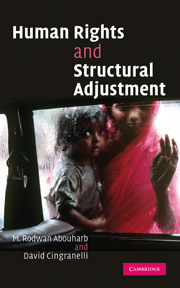Book contents
- Frontmatter
- Contents
- List of figures
- List of tables
- Acknowledgments
- Part I The argument
- 1 Structural adjustment programs undermine human rights
- 2 Respect for human rights promotes economic development
- 3 Theoretical linkages between structural adjustment and repression
- Part II Estimating the human rights effects of structural adjustment
- Part III Findings
- Part IV Conclusion
- Bibliography
- Author index
- Subject index
3 - Theoretical linkages between structural adjustment and repression
Published online by Cambridge University Press: 30 June 2009
- Frontmatter
- Contents
- List of figures
- List of tables
- Acknowledgments
- Part I The argument
- 1 Structural adjustment programs undermine human rights
- 2 Respect for human rights promotes economic development
- 3 Theoretical linkages between structural adjustment and repression
- Part II Estimating the human rights effects of structural adjustment
- Part III Findings
- Part IV Conclusion
- Bibliography
- Author index
- Subject index
Summary
Introduction
What is the impact of the World Bank and International Monetary Fund on government respect for human rights and on equitable economic development? Many different groups have protested that the impacts have been negative. Recent anti-structural adjustment demonstrations have taken place at the 1999 Ministerial Meeting of the World Trade Organization (WTO) in Seattle, at the annual meetings of the IMF and World Bank (in Washington DC on alternate years), and at the annual summits of the Group of 8 (G8) industrialized countries. There were massive protests at the 2005 Summit of the Americas in Mar del Plata (near Buenos Aires), at the 2000 Annual Meeting of the IMF and World Bank in Prague, and at the 2001 G8 meeting in Turin, among others. Protesters have questioned the motives and criticized the impacts of these institutions on the economies and societies of liberalizing countries. The popular press has reported upon the activities of these institutions extensively, with much criticism of the austerity measures that have been associated with structural adjustment agreements and their harsh consequences in developing countries. With emotions raised and hyperbole flowing, we need to step back and ask if the criticism of these institutions is warranted. Has the academic community generated any answers when trying to assess the impact of these institutions?
Recent studies which have controlled for what have become known as “issues of selection” have concluded that IMF structural adjustment agreements have deleterious consequences on economic growth (Przeworski and Vreeland 2000; Vreeland 2003).
- Type
- Chapter
- Information
- Human Rights and Structural Adjustment , pp. 50 - 78Publisher: Cambridge University PressPrint publication year: 2007



